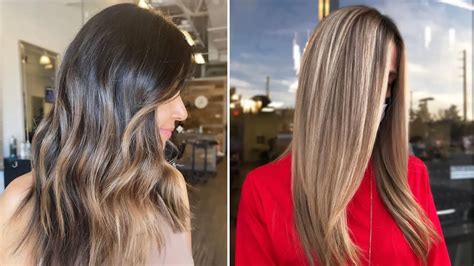Introduction

As the hair industry continues to evolve, innovative hair coloring techniques are emerging to cater to the ever-changing preferences of fashion-conscious individuals. Two of the most popular techniques – balayage and highlights – offer unique advantages and cater to distinct aesthetics. Their subtle yet impactful differences can significantly alter the overall look and feel of your hair, making it crucial to understand their intricacies before making a decision.
1. What is Balayage and Highlights?
Balayage
Balayage is a freehand hair painting technique that involves applying color in sweeping motions to create subtle, sun-kissed effects. It aims to mimic the natural lightening that occurs from sun exposure, resulting in a more natural and effortless appearance.
Highlights
Highlights, on the other hand, involve creating distinct, visible strands of lighter color throughout the hair. They are applied using a cap, foil, or balayage board to isolate small sections and bleach them to achieve the desired level of lightening.
2. Technique and Application
Balayage
Balayage is applied freehand, allowing the stylist to customize the placement and intensity of the color. The stylist uses a brush to paint the color onto the surface of the hair, creating soft, blended transitions.
Highlights
Highlights require a more structured approach. The hair is sectioned off and either a cap or foil is used to isolate the strands to be lightened. Bleach is then applied and processed, creating distinct, lighter strands.
3. Color Placement and Distribution
Balayage
Balayage focuses on creating a more natural, sun-kissed look. The color is concentrated on the mid-lengths and ends of the hair, with softer blending towards the roots. This creates a gradient effect that adds dimension and movement.
Highlights
Highlights, on the other hand, can be placed anywhere on the hair, from the roots to the tips. The placement and distribution depend on the desired effect, whether it’s a subtle enhancement or bold statement.
4. Customization and Versatility
Balayage
Balayage offers a high degree of customization. The stylist can control the placement, intensity, and blending of the color to create a unique look tailored to the individual’s facial features, hair type, and personal style.
Highlights
Highlights allow for versatility in terms of placement and color selection. However, the distinct nature of the technique limits the ability for seamless blending.
5. Maintenance and Regrowth
Balayage
Balayage requires less maintenance compared to highlights. The seamless blending ensures that regrowth is less noticeable, making touch-ups less frequent.
Highlights
Highlights typically require more frequent touch-ups as the roots grow out, creating a more visible contrast between the treated and untreated hair.
6. Damage and Hair Health
Balayage
Balayage is considered less damaging than highlights as it does not involve direct contact with the scalp or extensive bleaching. The color is applied to the surface of the hair, leaving the roots and underlying strands relatively untouched.
Highlights
Highlights can be more damaging, especially if the bleach is left on for extended periods or if the hair is already weak or damaged. The process of lifting the hair color can lead to dryness, breakage, and loss of elasticity.
7. Cost and Time
Balayage
Balayage is generally more expensive than highlights, as it requires a higher level of skill and artistry. It also tends to take longer to apply, as the stylist needs to create a seamless blend of color.
Highlights
Highlights are typically less expensive and can be done more quickly, as the application process is more standardized.
8. Which Hair Type is Suitable?
Balayage
Balayage is suitable for most hair types, including fine, thick, or curly hair. It can help add volume and movement to fine hair, and enhance the natural texture of thick or curly hair.
Highlights
Highlights are best suited for clients with naturally lighter hair or hair that has been previously lightened. They can help add depth and dimension to hair that is already light, but may not be as effective on darker hair.
9. Benefits of Balayage vs. Highlights
Balayage
- Natural, sun-kissed look
- Low maintenance
- Less damaging
- Suitable for all hair types
- Customisable
Highlights
- Bold, statement-making effect
- Versatile placement options
- Can add depth and dimension
- Best suited for light hair
10. How to Choose Between Balayage and Highlights
The decision between balayage and highlights depends on several factors, including:
- Desired look
- Hair type
- Maintenance preferences
- Budget and time constraints
Tips for Choosing the Right Technique for You:
- Consider your natural hair color and texture.
- Discuss your desired look with a professional stylist who can assess your hair and recommend the best technique.
- Be realistic about maintenance and touch-up intervals.
- Don’t be afraid to experiment and try different techniques to find what suits you best.
Common Mistakes to Avoid:
- Over-bleaching your hair can lead to damage and breakage.
- Using the wrong color toner can result in unwanted brassiness or yellow tones.
- Neglecting proper hair care can compromise the health and longevity of your color.
Conclusion
Both balayage and highlights offer distinct advantages and cater to different preferences. Balayage provides a natural, low-maintenance look, while highlights create bolder, more defined results. Understanding the key differences between these techniques can empower you to make an informed decision that aligns with your hair goals and lifestyle. By choosing the right technique and following proper care guidelines, you can achieve stunning, healthy hair with the perfect touch of color.
